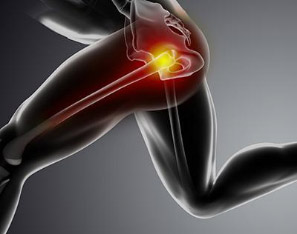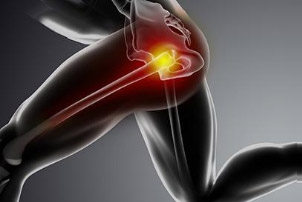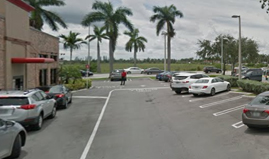Author: Dr. J. Pieter Hommen

To see if you are a candidate for a proximal hamstring tendon repair, Request an Appointment Online or call 305-520-5625.
- What is a Proximal Hamstring Tendon Tear?
- What is a Pulled Hamstring, a Hamstring Strain, or a Hamstring Tear?
- What isa Proximal Hamstring Tear?
- What are the Symptoms of a Proximal Hamstring Tendon Avulsion Tear?
- How can a Proximal Hamstring Tendon Tear be Diagnosed?
- How to Treat Proximal Hamstring Tendon Tears Without Surgery?
- How can a Proximal Hamstring Tendon Tear be Repaired?
- What are the Proximal Hamstring Tendons?
There are four hamstring muscles in the thigh. Each muscle is attached to bone by way of a tendon. At the proximal end, three of the hamstring tendons originate off the pelvis bone at the ischium otherwise known as the “sits” bones. The muscles then course down the thigh distally towards the knee. They become tendons distally and attach at the knee on the tibia and fibula bone. Because they cross the hip and the knee, the hamstrings function primarily to flex the knee and extend the hip. They also rotate the leg internally and externally. Normal functioning hamstrings are essential for everyday function such as walking and getting up from a chair as well as high level activities such as sprinting.
- What is a Pulled Hamstring, a Hamstring Strain, or a Hamstring Tear?
A pulled hamstring, also known as a hamstring strain, is a tear of the hamstring muscle fibers or the tendon by way the muscle attaches to the bone. The weakest link and the most common area of hamstring injuries tends to be at the junction of the tendon and muscle, however, injuries can also occur at the bone-tendon interface or within the muscle belly. A grade I hamstring injury denotes a less severe hamstring strain at a microscopic level. The muscle fibers or the tendon is essentially stretched too far, and some bleeding may occur within the muscle. In very severe hamstring strains, or grade III injuries, the hamstring muscle or tendon can completely rupture. Hamstring injuries most commonly occur because of what is called an "eccentric contraction." When this occurs, the muscle is trying to contract while another force (the ground, another player, etc.) is forcing the muscle in the opposite direction. This creates tremendous force along the junctions of the hamstrings, and if the force is strong enough, it will tear the tendon or muscle fibers.
- What is a Proximal Hamstring Tendon Tear?
Hamstring injuries that occur at the very top of the thigh are known as proximal hamstring tears. The reason for their special recognition is that certain proximal hamstring injuries may require surgery, whereas most distal hamstring tears can be treated conservatively. Tears of the proximal hamstrings can be divided into either a) tears of the tendons from their origin at the pelvic ischium or b) tears more distally along the tendon-muscle interface as it courses down the back of the thigh. They can also be further divided into partial and complete tears.
A complete avulsion tear of the proximal hamstrings occurs when the hamstrings are peeled off the ischium of the pelvis. These tears generally occur in people over the age of 40 due to a traumatic and sudden injury such as during a sprint or from a fall. A partial, or incomplete tear of the tendon means that there is minimal tearing or separation of the tendons from the bone. Partial tears are usually from lower levels of trauma or from repetitive injuries and can allow for the muscles to continue to contract and function, however often with pain. A complete avulsion tear means that the tendons are no longer attached to the ischium of the pelvis and therefore one or more muscles can no longer continue its normal function.
- What are the Symptoms of a Proximal Hamstring Tendon Avulsion Tear?
Patients who tear their proximal hamstrings from a trauma such as sprinting, falling, or water skiing often report a sharp and sudden pain in the “sits bones” area of the buttocks. A tell-tale sign of a complete avulsion tear is the development of an area of bruising along the back of the thigh, knee and even the upper calf. Patients with partial tears usually present with a more insidious, or gradual, onset of pain. Patients with both partial and complete avulsion injuries often continue to have symptoms of chronic pain at the “sits-bones” when seated on hard chairs and often complain of the sensation of “sitting on a walnut”. They can also complain of pain with hamstring stretch activities and with high levels of activity such as sprinting. Patients with complete tears often have persistent weakness and may find jogging, running or jumping difficult or impossible.
Patients with higher grade and traumatic tears may also develop sciatic nerve symptoms such as tingling, burning, numbness or electrical pain radiating down the leg due to the irritation of the sciatic nerve which runs next to the hamstrings.
- How can a Hamstring Tendon Tear be Diagnosed?
A hamstring tendon tear is best diagnosed with an MRI scan of the proximal hamstring. A stronger MRI scan machine with a 1.5 or 3.0 Tesla magnet strength can help to differentiate lower grade hamstring tendonitis from a partial tear or complete tear. It can also differentiate a proximal hamstring avulsion tear from a more distal hamstring tear at the proximal muscle-tendon junction or even more distally within the muscle belly. The scan can also help determine if the tear is amenable to a repair or conservative management. Your orthopedic surgeon may also perform an ultrasound scan in the office to rule out a proximal hamstring tear.
- How to Treat Proximal Hamstring Tendon Tears Without Surgery?
A tear of the proximal hamstring tendons may be treated with conservative options that may not require surgery. A course of physical therapy and home exercise program may help strengthen the surrounding hip muscles and reduce pain. An ultrasound guided cortisone injection or platelet rich plasma (PRP) can be performed in the office into a partial tear or tendonitis to reduce pain and possibly to stimulate the healing process. Return to normal activities is variable depending largely on the type of activity as well as the location and severity of the tear.
- How can a Proximal Hamstring Tendon Tear be Repaired?
Your surgeon may determine if surgery is appropriate. For those who have failed conservative treatments and remain symptomatic, the hamstring tendons can be surgically repaired to restore function and treat the pain. The repair can be performed arthroscopically similar to knee or shoulder surgery using a small camera and instruments inserted through small key-hole incision sites around the hip. This can drastically minimize the surgical recovery time and pain. Arthroscopic surgery in many cases may also provide for a better visualization and repair of the tear than open techniques. In certain cases such as a large and chronically retracted hamstring tear or a tear with sciatic nerve involvement, an open approach is advisable. Surgical repair of the proximal hamstrings entails the direct repair of the tendons to their ischium origin with suture anchors. Given the proximity of the sciatic nerve, a neurolysis of the nerve may be performed to remove it from encased scar tissue from the hamstring injury.
To see if you are a candidate for a proximal hamstring tendon repair, Request an Appointment Online or call 305-520-5625.
- What are the Proximal Hamstring Tendons?














